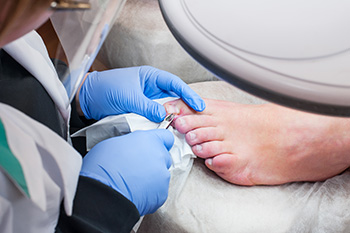 Ingrown toenails occur when the nail grows into the surrounding skin, which causes pain and has a potential for infection. Podiatrists, or foot doctors, can treat ingrown toenails through a variety of procedures depending on the severity. For less severe cases, a podiatrist may carefully trim the ingrown portion of the nail and instruct the patient on proper nail care techniques to prevent recurrence. If the ingrown toenail is more problematic or keeps coming back, a podiatrist might perform a partial nail avulsion. This involves numbing the toe and then removing the ingrown section of the nail. In some cases, a podiatrist may also apply a chemical called phenol to the affected nail root to prevent the problematic portion of the nail from growing back. These procedures are generally quick, done with minimal discomfort, and allow patients to return to daily activities fairly quickly. If you are suffering with an ingrown toenail, it is suggested that you consult a podiatrist for treatment and to prevent the ingrown toenail from returning.
Ingrown toenails occur when the nail grows into the surrounding skin, which causes pain and has a potential for infection. Podiatrists, or foot doctors, can treat ingrown toenails through a variety of procedures depending on the severity. For less severe cases, a podiatrist may carefully trim the ingrown portion of the nail and instruct the patient on proper nail care techniques to prevent recurrence. If the ingrown toenail is more problematic or keeps coming back, a podiatrist might perform a partial nail avulsion. This involves numbing the toe and then removing the ingrown section of the nail. In some cases, a podiatrist may also apply a chemical called phenol to the affected nail root to prevent the problematic portion of the nail from growing back. These procedures are generally quick, done with minimal discomfort, and allow patients to return to daily activities fairly quickly. If you are suffering with an ingrown toenail, it is suggested that you consult a podiatrist for treatment and to prevent the ingrown toenail from returning.
Ingrown toenails may initially present themselves as a minor discomfort, but they may progress into an infection in the skin without proper treatment. For more information about ingrown toenails, contact Dr. John P. Beaupied of Palos Podiatry. Our doctor can provide the care you need to keep you pain-free and on your feet.
Ingrown Toenails
Ingrown toenails are caused when the corner or side of a toenail grows into the soft flesh surrounding it. They often result in redness, swelling, pain, and in some cases, infection. This condition typically affects the big toe and may recur if it is not treated properly.
Causes
- Improper toenail trimming
- Genetics
- Improper shoe fitting
- Injury from pedicures or nail picking
- Abnormal gait
- Poor hygiene
You are more likely to develop an ingrown toenail if you are obese, have diabetes, arthritis, or have any fungal infection in your nails. Additionally, people who have foot or toe deformities are at a higher risk of developing an ingrown toenail.
Symptoms
Some symptoms of ingrown toenails are redness, swelling, and pain. In rare cases, there may be a yellowish drainage coming from the nail.
Treatment
Ignoring an ingrown toenail can have serious complications. Infections of the nail border can progress to a deeper soft-tissue infection, which can then turn into a bone infection. You should always speak with your podiatrist if you suspect you have an ingrown toenail, especially if you have diabetes or poor circulation.
If you have any questions, please feel free to contact our office located in Palos Heights, IL . We offer the newest diagnostic and treatment technologies for all your foot care needs.



